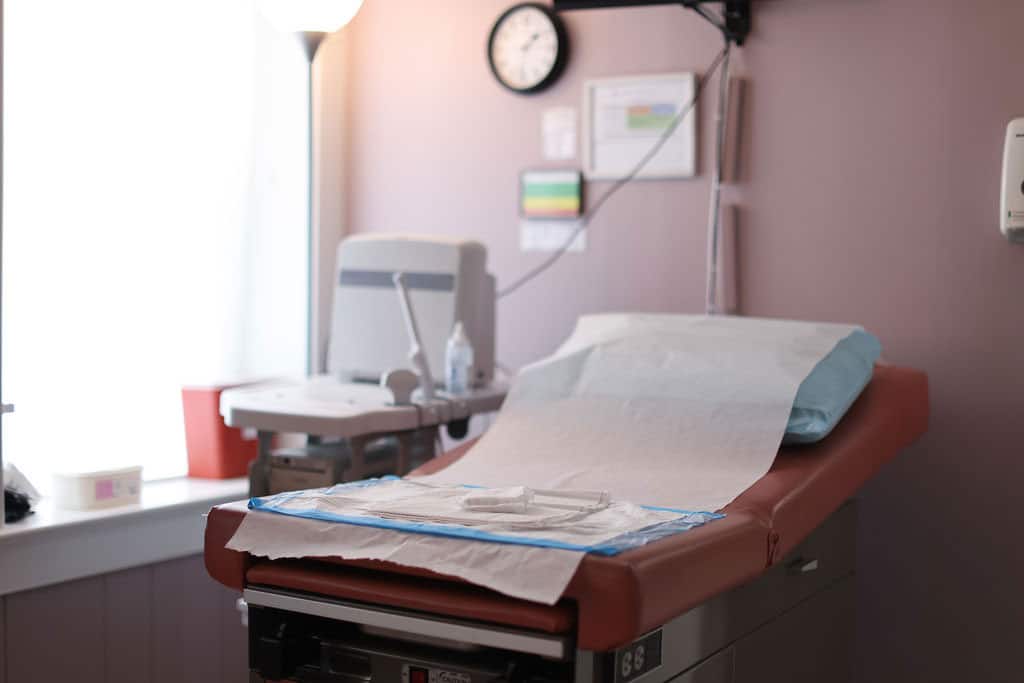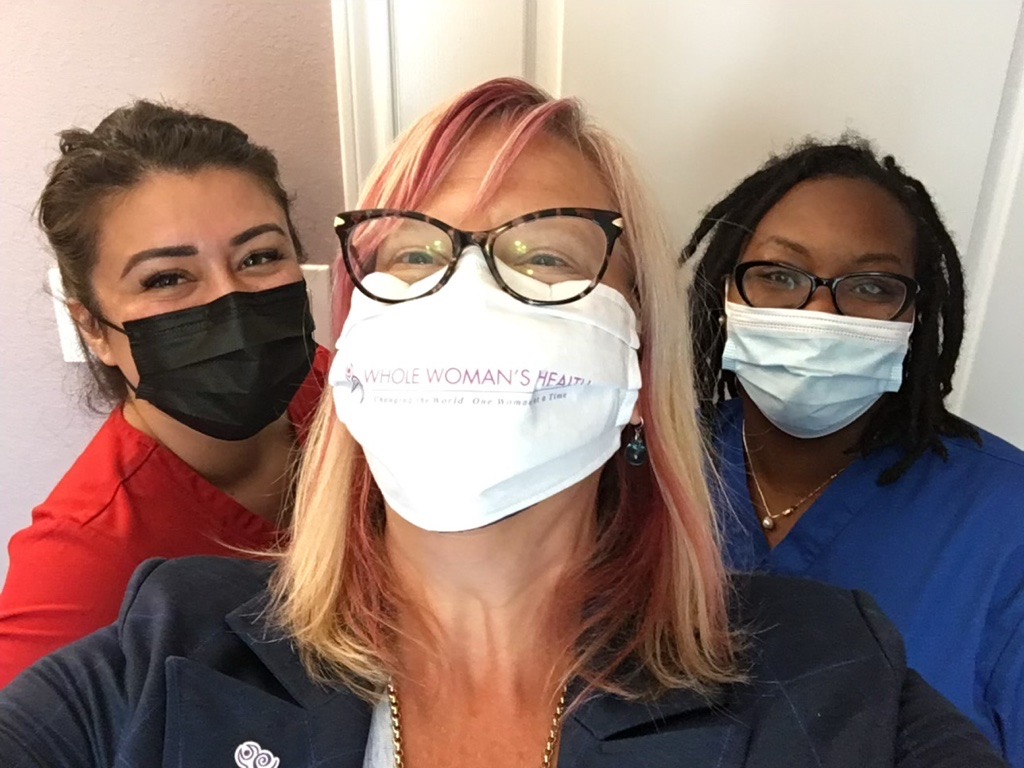Abortion Procedure
(under 16 weeks)
There are lots of reasons to choose to have an in-clinic aspiration abortion procedure. Some people prefer sedation options, some folks want to know they are no longer pregnant immediately after the procedure, and others like the support and comfort our doctors, nurses, and staff provide. Other folks want to use their health insurance to cover their abortion – these are just some reasons our patients choose abortion care in our clinics. Patients under 12 weeks from their last period can choose between a medication abortion or an aspiration abortion procedure in our clinic. Aspiration abortion is what we offer from 12 to 16 weeks, and the D&E procedure is for folks 16 weeks or more. We offer comfort medications for all in-clinic procedures.

Aspiration abortion works by using suction to take the pregnancy out of your uterus. Depending on how many weeks you are into your pregnancy, there are a couple of methods used for in-clinic abortion procedures. Your doctor or nurse will know which type is right for you.
A suction abortion (also called vacuum aspiration) is the most common type of in-clinic abortion. It uses gentle suction to empty your uterus. It’s usually used until about 14-16 weeks after your last period.
Dilation and Evacuation (D&E) is another kind of in-clinic abortion procedure. It uses suction and medical instruments to empty your uterus. This procedure is typically used if it has been 16 weeks or longer since your last period.
In-clinic abortions are extremely effective. They work more than 99 out of every 100 times. It is very rare that a re-suction procedure is needed, but if that were to happen, we will be here to help.
You can get an abortion procedure as soon as you have a positive pregnancy test.
The laws in your state will determine many aspects of how you can get an abortion. Some states have lots of restrictions, and others have less. We can help you learn what you need to know.
What kind of abortion you choose is your personal preference and situation. Some people choose in-clinic abortion because they want to have their procedure done at a health center. They want to have trained providers and staff there the whole time, and they may prefer sedation for comfort. (With the abortion pill, you have the abortion at home.)
In-clinic abortions are faster than the abortion pill. Most in-clinic abortions only take about 5-10 minutes, while a medication abortion may take up to 24 hours to complete. You may also opt for sedation with an in-clinic abortion.
Our trained staff can help you decide which kind of abortion is best for you.
Before your abortion, you’ll get pain medicine to help with cramping. Our patients are also always given local anesthesia and may also choose additional Oral or IV Sedation during the procedure. With sedation, you’re awake but really relaxed. You’ll also get antibiotics to help prevent infection.
Once you’re in the procedure room, there will be a staff member there to assist the provider and support you during the abortion.
During an abortion, the provider will:
Once your abortion is over, you’ll rest in a recovery area with our medical staff until you feel better and are ready to leave. We offer special tea, snacks, and opportunities for support.
A first-trimester abortion procedure usually takes between 4 and 5 minutes. Your clinic visit that day includes an ultrasound, lab work, exam, counseling/ consenting, and a short stay in the recovery room afterward for up to about an hour, so your total time in our clinic is usually around 4 hours.
If you are in your second trimester – meaning that it’s been more than 13 weeks since your last menstrual period – you will likely have a dilation and evacuation, or D&E, procedure.
D&E is usually used for abortions at 16 weeks or more after your last period. Before a D&E abortion, your provider will prepare your cervix. This means you may get medication that helps open your cervix. Your doctor might also put small dilator sticks called laminaria into the opening of your cervix either overnight or for a few hours before the procedure. The laminaria absorb fluid from your body and get bigger, slowly opening your cervix.
Before your abortion, you’ll get pain medicine to help with cramping. Our patients are also always given local anesthesia and may also choose additional Oral or IV Sedation during the procedure. With sedation, you’re awake but really relaxed. You’ll also get antibiotics to help prevent infection.
Once you’re in the procedure room, there will be a staff member there to assist the provider and support you during the abortion.
During a D&E abortion, the provider will:
Once your abortion is over, you’ll rest in a recovery area with our medical staff until you feel better and are ready to leave. We offer special tea, snacks, and opportunities for support.
A D&E procedure usually takes between 10 and 20 minutes. Your clinic visit that day includes an ultrasound, lab work, exam, counseling/ consenting, preparing your cervix, and stay in the recovery room afterward for up to about an hour so the total time you are in our clinic is usually 4-6 hours.
Are you thinking about contraception? In most of our clinics, you can get an implant, shot, or prescription for birth control while you’re there. Most Whole Woman’s Health clinics can put an IUD in your uterus soon after your abortion. Ask our staff if you are interested!
Suction aspiration abortion procedures are very common. Abortion at any gestation is 14 times safer than childbirth. In terms of risk, abortions are similar to other gynecological procedures that take place in doctor’s offices every day.
Like any medical procedure, there are some risks. A few things that affect your risk level include your medical and pregnancy history, the gestation of your pregnancy, and if you have sedation or general anesthesia.
Serious complications are really rare but can happen. These include:
These problems are very rare, and they’re typically easy to treat. If the abortion doesn’t get all the pregnancy tissue out, you may need to have another procedure — this is not common.
In extremely rare cases, some complications can be very serious or even life-threatening. Call our clinic right away if you have:
If you have bad smelling discharge from your vagina, call to make an appointment. If you have any questions or concerns, you can always call. We have on-call staff support 24/7 365 days a week.
In-clinic aspiration abortion procedures are common and effective, and millions of people have gotten these abortions safely. There are lots of myths about the effects of an abortion. But here are some facts:
Serious, long-term emotional problems after an abortion are rare. They are about as uncommon as they are after giving birth. If there are issues, they are more likely to happen to people who have to end a pregnancy because of health reasons or people who have a history of mental health problems.
Our providers can give you accurate information about in-clinic abortion side effects, risks, or any other concerns you might have.
Find Your Way To The Abortion Care You Deserve
Whole Woman’s Health operates the Abortion Wayfinder Program to protect and expand access to abortion care for patients who are denied care because of bad laws in their home state. We help people find their way to the abortion healthcare they need. What’s more, we are working alongside abortion funds and allies to secure logistical and financial support for anyone needing to travel for abortion care.
Please call and ask for the Abortion Wayfinder Program to get connected. You can reach us in one of two ways:

Our friendly team is ready to answer any questions and get you started.
Note: A trained medical professional is the only way to accurately determine the length of your pregnancy and what options are available.
